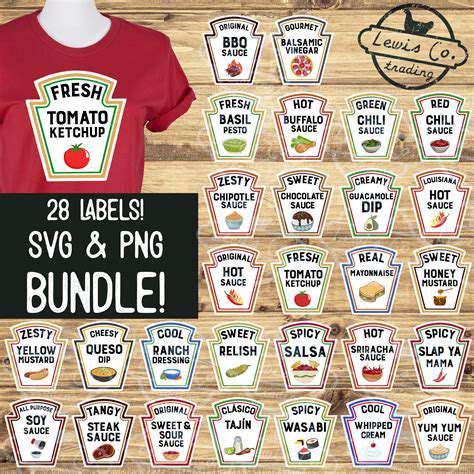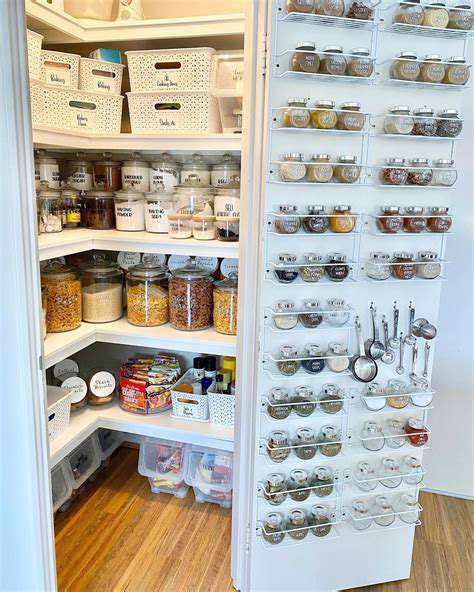Kitchen Organization for Condiments: Keep it Tidy
The Importance of Organized Condiments

Maintaining a Well-Organized Condiment Collection
A well-organized condiment collection is more than just a neat appearance; it's a significant contributor to a more efficient and enjoyable culinary experience. Having your condiments readily available and easily identifiable can save valuable time in the kitchen, allowing you to focus on the creative aspects of your cooking and meal preparation. Imagine rushing to a recipe's critical stage, only to discover that the crucial ingredient, like a rare hot sauce or a unique olive oil, is tucked away in the back of a cluttered cupboard. This frustration can easily derail your culinary ambitions and diminish the overall enjoyment of the meal. A systematic approach to storing condiments, like using clear containers and labeling them clearly, will significantly reduce this wasted time and enhance the joy of cooking. Proper organization also promotes a sense of order, which can contribute to a more focused and productive kitchen environment.
Furthermore, a well-organized condiment collection makes it easier to maintain a tidy and hygienic kitchen. When everything is easily accessible and visible, it's simpler to spot any signs of spoilage or contamination. This proactive approach to food safety ensures that you're using fresh and safe ingredients throughout your culinary adventures. Regular cleaning and maintenance of your condiment storage solutions are part of this practice. Clear and labeled containers not only aid in quick retrieval but also facilitate easy cleaning and help avoid cross-contamination.
Optimizing Space and Functionality
Proper condiment organization goes beyond aesthetics; it significantly improves the functionality of your kitchen. Strategic placement of condiments, based on frequency of use, can streamline your workflow and reduce wasted movements. This strategic placement also keeps your kitchen space feeling more organized and clutter-free.
Consider using vertical space for maximum efficiency. Utilizing shelves, tiered organizers, or even wall-mounted racks can maximize your kitchen's storage capacity without sacrificing valuable counter space. This allows you to keep frequently used condiments within easy reach while storing less used items out of the way. By optimizing your space in this way, you can create a more efficient and enjoyable cooking environment.
Employing clear, labeled containers for condiments is another crucial aspect of optimizing functionality. This not only improves the aesthetic appeal of your kitchen but also makes it much simpler to locate specific condiments quickly. This significantly reduces wasted time hunting for ingredients and ensures that you can focus on the more rewarding aspects of cooking.
Keeping condiments organized and easily accessible can elevate the overall experience of cooking and meal preparation. This organized approach makes meal preparation more efficient and enjoyable.
Categorizing and Grouping Your Condiments

Categorizing Your Content
Categorizing your content is a crucial step in organizing and managing your information. It allows you to easily find specific pieces of content when needed, improving productivity and workflow. By creating clear and consistent categories, you're essentially building a roadmap for your information, making it easier to navigate and understand the relationships between different pieces of content. This process is not just about creating labels; it's about thoughtfully defining how your content fits together, reflecting the underlying structure and logic of your work.
A well-defined categorization system can also significantly enhance searchability. When you use a consistent and logical approach to categorizing your content, search functions become more effective. This is particularly helpful in larger projects where finding specific documents or files can be time-consuming without a structured approach. Think of your categories as folders in a digital filing system; the more organized your folders, the easier it is to find what you need.
Grouping Related Content
Grouping related content is another essential aspect of content management. It's about recognizing the connections between different pieces of information and bringing them together under a common umbrella. This grouping process clarifies the relationships between various topics and enhances your understanding of the overall project or subject matter.
Grouping your content logically can reveal patterns and insights you might have missed otherwise. For example, if you're writing a research paper, you might group different sources of data based on their methodology, timeframe, or specific argument. This grouping can help you to identify gaps in your research or to synthesize different points of view more effectively. Grouping also makes it easier to locate and review all the relevant materials for a particular aspect of your work.
Developing a Consistent System
Establishing a consistent system for categorizing and grouping your content is vital for long-term organization and efficiency. A consistent system ensures that your content is always filed and organized in a predictable manner, making it easy for you and others to locate information quickly and easily. This predictability is especially important for large teams or projects where multiple individuals need access to and work with the same content.
A well-defined and consistently applied system saves time and reduces frustration. It eliminates the ambiguity surrounding how to find or organize content, making it easier to collaborate effectively and preventing valuable time from being wasted on searching. Moreover, creating a system for organizing and categorizing your content early on will set the stage for a more productive and efficient workflow throughout the duration of your project.

- Storing Rice and Grains: Pantry Best Practices
- Exploring Vietnamese Cuisine: Flavorful Soups and Noodles
- Grilling Basics: Perfect Burgers Every Time
- Dairy Free Desserts: Creamy Vegan Ice Cream Recipe
- Simple Soup Recipes: Warm and Satisfying
- Cooking with Pressure Cooker Accessories: Expand Your Options
- Classic American Comfort Food: Hearty Chili Recipe
- Homemade Brownies: Fudgy and Irresistible
- Simple Vegetable Side Dishes: Easy and Flavorful
- Preventing Food Waste: Creative Ways to Use Up Leftovers
- Vegetarian Meal Prep Bowls: Easy and Nutritious
- A Taste of Thailand: Authentic Pad Thai Recipe